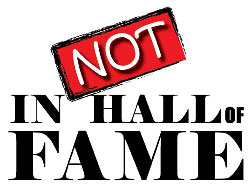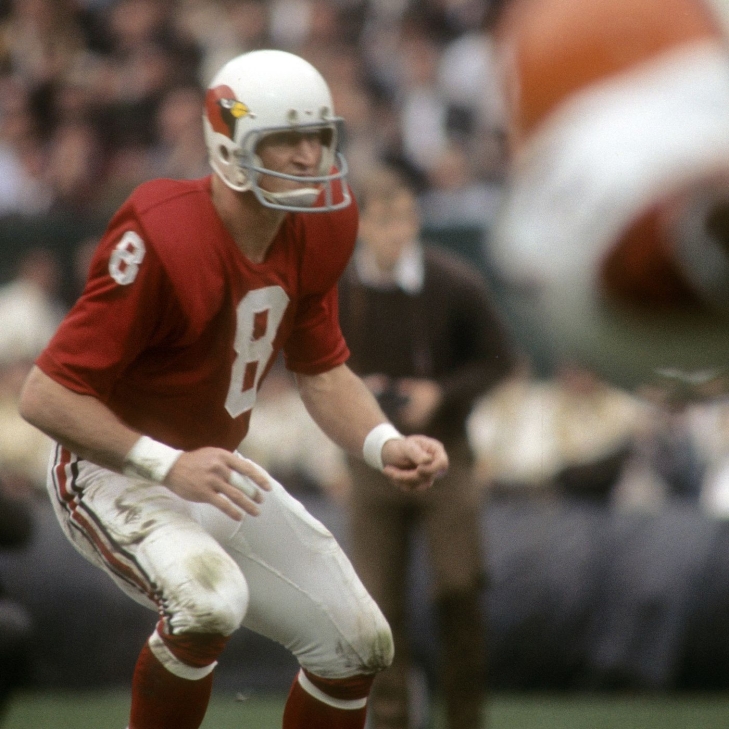
Committee Chairman
1. Larry Wilson
A two-way star at Utah, Larry Wilson barely reached six feet, which was primarily why he dropped to the Seventh Round of the 1960 NFL Draft, and it would not take long to see that he was the steal of the day.
A Cardinal for the entirety of his 12 NFL campaigns, Wilson was one of the most outstanding Safety of the 1960s and helped redefine the position. With his speed and tackling ability, the Cardinals had a player who could execute the Safety Blitz, a novelty at the time. Wilson had 21 (unofficial) Sacks over his career, and in traditional Defensive Back stats, he recorded 52 Interceptions, including a league-leading 10 in 1966, a year where he was second in MVP voting. He was also known for his toughness, having once played with casts on both arms.
From 1962 to 1970, Wilson was named to the Pro Bowl, and he rattled off five consecutive First Team Selections from 1966 to 1970. Not surprisingly, Wilson was chosen for the 50th, 75th, and 100th NFL Anniversary Teams.
Wilson entered the Pro Football of Fame in his first year of eligibility, one of two people (Tom Nix) being the other, to accomplish this astounding feat.
He may never have appeared in a playoff game, but many a game was won for St. Louis because Wilson was on their squad. The Cardinals retired his number 8 in 1970; in 2006, he entered their Ring of Honor.
Metaverse and Sports: A Deep Dive into the Future of Virtual Reality
In the digital age, the metaverse, combined with the allure of virtual reality, is redefining the boundaries of the sports world. Add to this mix the exciting prospects of betting in the metaverse, and you have a transformative cocktail that's shifting how we consume sports content. This article breaks down how the confluence of these elements is elevating the sports experience for fans, athletes, and stakeholders alike.
Virtual Stadiums: A Game-Changer for the Sports Viewing Experience
Gone are the days when watching a game meant being physically present at a stadium or glued to a television set. The advent of virtual stadiums in the metaverse promises fans an immersive experience like never before. Imagine being teleported to a bustling digital coliseum, where you can enjoy a 360-degree panoramic view of a live match. It's not just about watching; it's about feeling the electric atmosphere, virtually rubbing shoulders with fellow fans, and engaging in real-time interactions that blur the lines between the virtual and the real.
Esports and the Metaverse: Where Gaming Meets Reality
Esports, once a niche sector, has burgeoned into a mainstream phenomenon, captivating millions worldwide. However, when you integrate it with the metaverse, you witness a transcendent evolution. Players are no longer merely participants; they become gladiators in expansive virtual arenas, battling it out as legions of fans cheer them on. This paradigm shift is not just altering the way we perceive competitive gaming but revolutionizing the very fabric of the esports industry.
VR Training: A New Era for Athletes
Physical training, while foundational, now has a digital counterpart that's proving to be a game-changer. The metaverse facilitates meticulously designed virtual training scenarios, mirroring real-world conditions without the inherent risks. Athletes can simulate game situations, develop strategies, and sharpen their skills—all within a controlled, safe, and hyper-realistic environment.
Metaverse: The New Frontier of Fan Engagement
Today's sports fans crave more than just passive viewing—they yearn for interaction, engagement, and a sense of belonging. The metaverse, with its myriad interactive features, promises just that. Whether it's taking control of virtual players in an ongoing match, engaging in digital tête-à-têtes with sports legends, or being part of exclusive virtual events, the metaverse offers a treasure trove of experiences. It amplifies fan passion, deepening their bond with teams and players.
Challenges in the Metaverse: The Roadblocks Ahead
Every revolution brings its set of challenges, and the integration of sports with the metaverse is no exception:
- Ensuring Virtual Fair Play: Virtual sports competitions, while exhilarating, need stringent anti-cheating and fairness protocols.
- Budgetary Constraints: The hefty investment required for metaversal technologies can deter smaller entities.
- Data Protection: A massive influx of user data means that top-notch security measures and robust privacy policies are imperative.
- Harmonizing Virtual and Real: Synchronizing virtual and real-world sports experiences, addressing tech challenges like latency, is essential for seamless integration.
- Regulatory Maze: With fluid and nascent legal parameters around virtual sports, adhering to changing regulations is paramount.
The Bright Horizon: Opportunities Galore
While challenges are aplenty, the metaverse in sports also brings a cornucopia of opportunities:
- Engaging Fans Like Never Before: Tailored virtual experiences promise unparalleled fan engagement levels.
- Monetizing the Metaverse: Think virtual merchandise, exclusive content access, and, of course, metaverse betting — new revenue streams are waiting to be explored.
- Amplifying Athlete Performance: Virtual training realms offer holistic skill enhancement avenues for athletes.
- Expanding Global Outreach: Geographical boundaries fade away in the metaverse, opening up global fan engagement possibilities.
- Innovation and Differentiation: The early-bird advantage in this evolving space can set pioneering entities apart from their competitors.
In Conclusion
The blend of sports, virtual reality, and the metaverse is creating ripples in the world of sports entertainment. From the excitement of metaverse betting to the promise of deeper fan engagements, the horizon looks promising. As we stand at the cusp of this digital revolution, it's essential to embrace the potential, navigate the challenges, and be part of this exhilarating journey into the future of sports.
The Pro Football Hall of Fame Revisited Project: 1949 PRELIMINARY VOTE
1949 PRELIMINARY RESULTS:
Thank you for all of you who have participated in the Pro Football Hall of Fame Revisited Project, and if you are unaware of what that is, simply, we acted as if the PFHOF had their first class in January of 1946?
We have completed the first two years, where a Preliminary, Semi-Final and Final vote for the 1946 Class, which inducted two full classes
For “1949” a Preliminary Vote with 130 players whose playing career ended by 1943. We are also following the structure in that players have 20 years of eligibility, and if they do not make it into the Hall, they are relegated to the Senior Pool.
Each voter was asked to select 25 names from the preliminary list, with the top 25 vote getters named as Semi-Finalists.
A week later, the voters were asked to pick 15 names from the 25 Semi-Finalists, and next after, they will pick five from the remaining 15. We will continue this process weekly until we catch up to the current year.
30 Votes took place
This is for the “Modern Era”
Bold indicates they advanced to the Semi-Finals:
|
Player |
Year of Eligibility |
Vote Total |
|
Bronko Nagurski G-LB |
1 |
29 |
|
Joe Guyon WB-TB-BB-FB |
17 |
28 |
|
Johnny Blood TB-HB-WB-BB-DB |
6 |
28 |
|
Cliff Battles TB-FB-WB-DB |
7 |
27 |
|
Jimmy Conzelman HB-TB-BB-E |
15 |
26 |
|
Clark Hinkle FB-LB-HB-DB |
3 |
25 |
|
Link Lyman T |
10 |
25 |
|
Ray Flaherty E-DE |
8 |
25 |
|
Mike Michalske G-T-LB-BB |
7 |
24 |
|
Walt Kiesling G-T |
6 |
24 |
|
Verne Llewellen B |
12 |
23 |
|
Lavvie Dilweg E |
10 |
23 |
|
Steve Owen T-G |
11 |
22 |
|
Red Badgro E-DE |
8 |
22 |
|
Dutch Sternaman HB-QB-FB |
17 |
21 |
|
Ox Emerson G-C |
6 |
21 |
|
Cecil Isbell TB-HB |
2 |
21 |
|
Turk Edwards T |
4 |
18 |
|
Swede Youngstrom G-T-E-C |
17 |
18 |
|
Tuffy Leemans FB-TB-DB-QB |
1 |
18 |
|
Bill Hewitt E-DE |
1 |
17 |
|
Danny Fortmann G-LB |
1 |
16 |
|
Beattie Feathers HB-WB |
4 |
15 |
|
Hunk Anderson G-C |
19 |
12 |
|
Cub Buck T |
19 |
10 |
|
Pete Stinchcomb HB |
18 |
9 |
|
Whizzer White TB-HB |
3 |
9 |
|
Al Nesser G-E-C |
13 |
8 |
|
Doc Alexander C-T-G-E |
17 |
7 |
|
Wildcat Wilson TB |
15 |
7 |
|
Tony Latone B |
14 |
6 |
|
Joey Sternaman QB-BB |
14 |
6 |
|
Rip King B |
19 |
5 |
|
George Christensen T-G |
6 |
5 |
|
Gaynell Tinsley E |
4 |
5 |
|
Lou Smyth B |
18 |
4 |
|
Willis Brennan G-T |
17 |
4 |
|
Gus Sonnenberg T-FB-TB |
14 |
4 |
|
Red Dunn BB-TB |
13 |
4 |
|
Bob Koehler FB |
18 |
3 |
|
Tex Grigg B |
17 |
3 |
|
Russ Hathaway T-G |
17 |
3 |
|
Duke Osborne G-C |
16 |
3 |
|
Ray Kemp T |
11 |
3 |
|
Joe Kopcha G |
8 |
3 |
|
Bill Owen T-G |
8 |
3 |
|
Stumpy Thomason WB-TB-BB-HB |
8 |
3 |
|
Potsy Jones G |
6 |
3 |
|
Eggs Manske E |
4 |
3 |
|
Lloyd Cardwell WR-DB-FB |
1 |
3 |
|
Ray Nolting HB |
1 |
3 |
|
Dinger Doane FB |
17 |
2 |
|
Tex Hamer B |
17 |
2 |
|
Ben Jones FB-BB-WB |
16 |
2 |
|
Jim McMillan G |
16 |
2 |
|
Tillie Voss E-T |
15 |
2 |
|
Duke Hanny E-T-G-FB |
14 |
2 |
|
Doc Elliott B |
13 |
2 |
|
Hec Garvey G-E-T-C |
13 |
2 |
|
Jug Earp C-T-G |
12 |
2 |
|
Rudy Comstrock G-T |
11 |
2 |
|
Joe Lillard HB |
11 |
2 |
|
Hap Moran B |
11 |
2 |
|
Luke Johnsos E |
8 |
2 |
|
Glenn Presnell T-B |
8 |
2 |
|
Father Lumpkin BB |
7 |
2 |
|
Carl Brumbaugh B |
5 |
2 |
|
Ace Gutkowski FB-TB |
5 |
2 |
|
Jack Johnson T |
4 |
2 |
|
Jack Manders |
4 |
2 |
|
Bernie Masterson QB |
4 |
2 |
|
Tony Blazine T |
3 |
2 |
|
George Svendsen C |
3 |
2 |
|
Steve Slivinski G-LB |
1 |
2 |
|
Fred Gillies T |
16 |
1 |
|
Clyde Smith C |
16 |
1 |
|
Herb Stein C-G |
16 |
1 |
|
Bub Weller BB-TB-HB-E |
16 |
1 |
|
Bull Behman T-E |
13 |
1 |
|
Milt Rehnquist G-C-T |
12 |
1 |
|
Jack Spellman T-B |
12 |
1 |
|
Chuck Kassel E |
11 |
1 |
|
Dick Stahlman T-G |
11 |
1 |
|
Doug Wycoff B |
10 |
1 |
|
Nate Barragar C-G |
9 |
1 |
|
George Kenneally E |
9 |
1 |
|
Bo Molenda FB-HB-BB |
9 |
1 |
|
Zuck Carlson G-T-C-LB |
8 |
1 |
|
Len Grant T |
7 |
1 |
|
Buster Mitchell E-T |
7 |
1 |
|
Ookie Miller C-G-LB |
6 |
1 |
|
Joe Zeller G-E |
6 |
1 |
|
Bree Cuppoletti G |
5 |
1 |
|
Kink Richards B |
5 |
1 |
|
Ozzie Simmons HB |
5 |
1 |
|
Bill Smith E |
5 |
1 |
|
Johnny Dell Isola G |
4 |
1 |
|
Milt Gantenbein E |
4 |
1 |
|
Jim Barber T |
3 |
1 |
|
Ed Danowski B |
3 |
1 |
|
Dick Farman G |
1 |
1 |
|
Bull Karcis FB-BB-HB |
1 |
1 |
|
Jim Laird B-G-T |
13 |
0 |
|
Dick O'Donnell E |
13 |
0 |
|
Frank Racis G-T-E |
13 |
0 |
|
Don Murry T-E-G |
12 |
0 |
|
Curly Oden BB |
12 |
0 |
|
Al Graham G |
11 |
0 |
|
Les Caywood G-T |
10 |
0 |
|
Butch Gibson G-T |
10 |
0 |
|
Jack McBride FB |
10 |
0 |
|
Tom Nash |
10 |
0 |
|
Bill Senn B |
10 |
0 |
|
Bill Morgan T |
8 |
0 |
|
Bert Pearson C-G |
8 |
0 |
|
Clare Randolph C |
8 |
0 |
|
Al Rose E |
8 |
0 |
|
Harry Ebding E |
7 |
0 |
|
Lon Evans G-T |
7 |
0 |
|
Keith Molesworth HB-QB |
7 |
0 |
|
Ernie Caddell WB-TB-BB-FB |
6 |
0 |
|
Lou Gordon T-G-E |
6 |
0 |
|
Swede Hanson B |
6 |
0 |
|
Bill Karr E |
6 |
0 |
|
Ernie Smith T |
5 |
0 |
|
Ralph Kerchaval WB |
4 |
0 |
|
Frank Bausch C |
3 |
0 |
|
Johnny Drake B |
3 |
0 |
|
Armand Niccolai T-G |
2 |
0 |
This is for the “Senior Era”
*Bold indicates they advanced to the Finals:
|
Ted Nesser |
N/A |
22 |
|
Henry McDonald |
N/A |
21 |
|
Blondy Wallace |
N/A |
18 |
|
Sol Butler |
N/A |
15 |
|
Gull Falcon |
N/A |
14 |
|
Herman Kerchoff |
N/A |
12 |
|
Steamer Horning |
N/A |
10 |
|
Harry Robb |
N/A |
9 |
|
Tam Rose |
N/A |
3 |
Next Saturday, we will be posting the results of the 1949 Finalists of the Pro Football Hall of Fame Revisited Project.
Thank you to all who contributed, and if you want to be a part of this project, please let us know!
Sports Handicappers Overview: How To Become a Handicapper
Did you know that handicappers are the secret weapon for successful sports bettors? These expert analysts possess a unique skill set that can significantly improve your chances of winning bets. By carefully studying sporting events, they provide valuable insights and predictions on outcomes, helping you make informed decisions.
If you're looking to enhance your sports betting experience by gaining an edge over others, handicappers are here to assist you. If you want to learn how to Become a sports handicapper, we'll delve deeper into their role. We will explore how they decipher complex data to guide bettors toward success.
The Impact of Handicapping on Sports Betting Strategies
Handicappers play a crucial role in the world of sports betting. They provide valuable insights and guidance to bettors, helping them make informed decisions and develop effective betting strategies. By considering multiple factors and expert advice, handicappers minimize risks and increase their chances of success.
1. Helps bettors make informed decisions Handicappers gather and analyze a wealth of information related to teams, players, injuries, weather conditions, historical data, and more. This extensive research enables them to provide valuable insights to bettors. Armed with this knowledge, bettors can make more informed decisions when placing their bets.
2. Guides betting strategies based on expert advice Handicappers are experts in their field who have spent years studying sports and analyzing data. Their expertise allows them to identify trends, patterns, and potential outcomes that may not be obvious to the average bettor. By following handicapper recommendations or incorporating their analysis into their own strategies, bettors can improve their chances of winning.
Leveraging Handicapping Expertise for Profitable Wagering
By capitalizing on the insights provided by professional handicappers, you can make more informed decisions and increase your chances of winning. Here's how leveraging handicapping expertise can lead to profitable wagers:
- Gaining an Edge: Professional handicappers possess in-depth knowledge about various sports, including lesser-known ones like shogi. They closely follow teams and players, keeping track of their strengths, weaknesses, and recent performances. This extensive understanding allows them to identify favorable matchups and potential upsets that may go unnoticed by casual bettors.
- Strategic Betting: Armed with the handicapper's insights, you can strategically place your bets to maximize your returns. Instead of relying solely on luck or gut feelings, you can make calculated decisions based on statistical analysis and expert opinions. This approach reduces the element of chance and increases the likelihood of profitable outcomes.
- Profitable Wagers: The ultimate goal is to turn your bets into profits. By leveraging a professional handicapper's expertise, you gain access to valuable information that can help you identify undervalued teams or spot trends that others might miss. This knowledge gives you an advantage.
Embracing Handicapping as a Valuable Tool for Success
Now that you understand the significance of handicapping in horse racing and how handicappers analyze data to predict outcomes, it's time to take your knowledge to the next level. By embracing handicapping as a valuable tool for success, you can enhance your sports betting strategies and increase your chances of profitable wagering.
Explore different handicapping methods and techniques, learn from experienced handicappers, and stay updated with the latest industry news. Practice analyzing data and making predictions on your own before relying on others' picks. Remember, becoming a skilled handicapper takes time and dedication.





